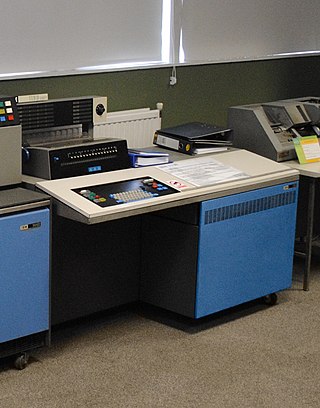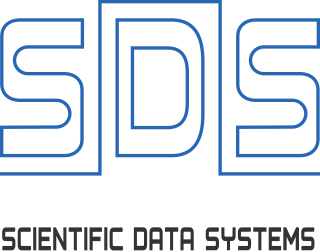Related Research Articles

The PDP–11 is a series of 16-bit minicomputers sold by Digital Equipment Corporation (DEC) from 1970 into the late 1990s, one of a set of products in the Programmed Data Processor (PDP) series. In total, around 600,000 PDP-11s of all models were sold, making it one of DEC's most successful product lines. The PDP-11 is considered by some experts to be the most popular minicomputer.

The IBM System/370 (S/370) is a model range of IBM mainframe computers announced on June 30, 1970, as the successors to the System/360 family. The series mostly maintains backward compatibility with the S/360, allowing an easy migration path for customers; this, plus improved performance, were the dominant themes of the product announcement. In September 1990, the System/370 line was replaced with the System/390.

The Xerox Alto is a computer designed from its inception to support an operating system based on a graphical user interface (GUI), later using the desktop metaphor. The first machines were introduced on 1 March 1973, a decade before mass-market GUI machines became available.

The IBM 1130 Computing System, introduced in 1965, was IBM's least expensive computer at that time. A binary 16-bit machine, it was marketed to price-sensitive, computing-intensive technical markets, like education and engineering, succeeding the decimal IBM 1620 in that market segment. Typical installations included a 1 megabyte disk drive that stored the operating system, compilers and object programs, with program source generated and maintained on punched cards. Fortran was the most common programming language used, but several others, including APL, were available.

The IBM 5100 Portable Computer is one of the first portable computers, introduced in September 1975, six years before the IBM Personal Computer, and eight before the first successful IBM compatible portable computer, the Compaq Portable. It was the evolution of a prototype called the SCAMP that was developed at the IBM Palo Alto Scientific Center in 1973. Whether considered evolutionary from SCAMP or revolutionary, it still needed to be plugged into an electric socket.
Disk Operating System/360, also DOS/360, or simply DOS, is the discontinued first member of a sequence of operating systems for IBM System/360, System/370 and later mainframes. It was announced by IBM on the last day of 1964, and it was first delivered in June 1966. In its time, DOS/360 was the most widely used operating system in the world.

Scientific Data Systems (SDS), was an American computer company founded in September 1961 by Max Palevsky, Arthur Rock and Robert Beck, veterans of Packard Bell Corporation and Bendix, along with eleven other computer scientists. SDS was an early adopter of integrated circuits in computer design and the first to employ silicon transistors. The company concentrated on larger scientific workload focused machines and sold many machines to NASA during the Space Race. Most machines were both fast and relatively low priced. The company was sold to Xerox in 1969, but dwindling sales due to the oil crisis of 1973–74 caused Xerox to close the division in 1975 at a loss of hundreds of millions of dollars. During the Xerox years the company was officially Xerox Data Systems (XDS), whose machines were the Xerox 500 series.
Plug compatible refers to "hardware that is designed to perform exactly like another vendor's product." The term PCM was originally applied to manufacturers who made replacements for IBM peripherals. Later this term was used to refer to IBM-compatible computers.

The CDC 3000 series are a family of mainframe computers from Control Data Corporation (CDC). The first member, the CDC 3600, was a 48-bit system introduced in 1963. The same basic design led to the cut-down CDC 3400 of 1964, and then the 24-bit CDC 3300, 3200 and 3100 introduced between 1964 and 1965. The 3000 series replaced the earlier CDC 1604 and CDC 924 systems.

Am2900 is a family of integrated circuits (ICs) created in 1975 by Advanced Micro Devices (AMD). They were constructed with bipolar devices, in a bit-slice topology, and were designed to be used as modular components each representing a different aspect of a computer control unit (CCU). By using the bit slicing technique, the Am2900 family was able to implement a CCU with data, addresses, and instructions to be any multiple of 4 bits by multiplying the number of ICs. One major problem with this modular technique was that it required a larger number of ICs to implement what could be done on a single CPU IC. The Am2901 chip was the arithmetic logic unit (ALU), and the "core" of the series. It could count using 4 bits and implement binary operations as well as various bit-shifting operations.

The SDS Sigma series is a series of third generation computers that were introduced by Scientific Data Systems of the United States in 1966. The first machines in the series are the 16-bit Sigma 2 and the 32-bit Sigma 7; the Sigma 7 was the first 32-bit computer released by SDS. At the time, the only competition for the Sigma 7 was the IBM 360.

Interdata, Inc., was a computer company, founded in 1966 by a former Electronic Associates engineer, Daniel Sinnott, and was based in Oceanport, New Jersey. The company produced a line of 16- and 32-bit minicomputers that were loosely based on the IBM 360 instruction set architecture but at a cheaper price. In 1974, it produced one of the first 32-bit minicomputers, the Interdata 7/32. The company then used the parallel processing approach, where multiple tasks were performed at the same time, making real-time computing a reality.
In computing, job control refers to the control of multiple tasks or jobs on a computer system, ensuring that they each have access to adequate resources to perform correctly, that competition for limited resources does not cause a deadlock where two or more jobs are unable to complete, resolving such situations where they do occur, and terminating jobs that, for any reason, are not performing as expected.
This timeline of binary prefixes lists events in the history of the evolution, development, and use of units of measure which are germane to the definition of the binary prefixes by the International Electrotechnical Commission (IEC) in 1998, used primarily with units of information such as the bit and the byte.

The history of the personal computer as a mass-market consumer electronic device began with the microcomputer revolution of the 1970s. A personal computer is one intended for interactive individual use, as opposed to a mainframe computer where the end user's requests are filtered through operating staff, or a time-sharing system in which one large processor is shared by many individuals. After the development of the microprocessor, individual personal computers were low enough in cost that they eventually became affordable consumer goods. Early personal computers – generally called microcomputers – were sold often in electronic kit form and in limited numbers, and were of interest mostly to hobbyists and technicians.
In computer architecture, 16-bit integers, memory addresses, or other data units are those that are 16 bits wide. Also, 16-bit central processing unit (CPU) and arithmetic logic unit (ALU) architectures are those that are based on registers, address buses, or data buses of that size. 16-bit microcomputers are microcomputers that use 16-bit microprocessors.
The IBM 2361 Large Capacity Storage (LCS) is an optional component of the IBM System/360 models 50, 65 (when not being used as a multiprocessor), and 75 computers. Storage is implemented using magnetic cores; the cycle time is 8 microseconds and the access time is 3.6 microseconds. This component is also called IBM 2361 Core Storage or IBM 2361 Large Core Storage. It provides additional main storage with a slower access time than the standard storage of the machine—for example its 8μsec compares to 750nsec for main storage on the Model 65.
The Universal Time-Sharing System (UTS) is a discontinued operating system for the XDS Sigma series of computers, succeeding Batch Processing Monitor (BPM)/Batch Time-Sharing Monitor (BTM). UTS was announced in 1966, but because of delays did not actually ship until 1971. It was designed to provide multi-programming services for online (interactive) user programs in addition to batch-mode production jobs, symbiont (spooled) I/O, and critical real-time processes. System daemons, called "ghost jobs" were used to run monitor code in user space. The final release, D00, shipped in January, 1973. It was succeeded by the CP-V operating system, which combined UTS with features of the heavily batch-oriented Xerox Operating System (XOS).
The Xerox Operating System (XOS) was an operating system for the XDS Sigma series of computers "optimized for direct replacement of IBM DOS/360 installations" and to provide real-time and timesharing support.

The IBM System/360 Model 50 is a member of the IBM System/360 family of computers. The Model 50 was announced in April 1964 with the other initial models of the family, and first shipped in August 1965 to the Bank of America.
References
- ↑ "Xerox 530 orders "encouraging"" . Democrat and Chronicle. 22 January 1974. p. 32.
- 1 2 Calkins, Keith. "The COMPUTER That Will Not Die: The SDS SIGMA 7" . Retrieved Sep 23, 2014.
- ↑ Xerox Corporation (1974). The Xerox 550 Computer Reference Manual (PDF). Retrieved Sep 24, 2014.
- ↑ "Xerox Announces a Computer for Companies with more Data than Money". Computerworld (Ad). Vol. VII, no. 6. Feb 7, 1973. p. 23. Retrieved Sep 23, 2014.
- ↑ "New Xerox Mini-Computer" . The New York Times. January 29, 1973. p. 39.
- 1 2 Rank Xerox. "Rank Xerox 530 Computer" (PDF). computerhistory.org. Retrieved Sep 23, 2014.
- ↑ "Xerox 530 to get COBOL". ComputerWorld. Vol. VII, no. 52. December 26, 1973. p. 13.
- ↑ "Real Machines with 16, 32, and 30-bit words".
- 1 2 3 Xerox Corporation (Sep 1973). Xerox 530 Computer Reference Manual (PDF). Retrieved Sep 22, 2014.
- ↑ Xerox Corporation. "XEROX OFFERS TWO MODELS OF A NEW COMPUTER LINE" (PDF). bitsavers.org. Retrieved Sep 23, 2014.
- ↑ Xerox Corporation (Jan 1974). Xerox 560 Computer Reference Manual (PDF). Retrieved Sep 22, 2014.
- ↑ Xerox Corporation. The Xerox 560 Computer (PDF). Retrieved Sep 22, 2014.
- ↑ "Rank/Xerox 530 Computer, 1973 ca" (PDF). ComputerHistory.org.
- ↑ "Xerox Program Availability List" (PDF). Bitsavers.org.
SIGMA 3 TO 1108 REMOTE JOB ENTRY
- ↑ Xerox Corporation. The Xerox 550 Computer (PDF). Retrieved Sep 22, 2014.
- ↑ "Operating systems list". Archived from the original on 7 April 2022.